When I was a kid, Joe, I used to have a dream. I was locked up overnight in a pastry shop, and there was goodies all around. There was jelly rolls, and mocha eclairs, and sponge cake and Boston cream pie.
—Daphne (played by Jack Lemmon) in the movie Some Like It Hot (1959)
Boston cream pie– not a pie, not cream, and probably not from Boston. Boston cream pie consists of two layers of either yellow butter cake or sponge cake sandwiched with vanilla pastry cream and topped with a soft chocolate glaze. The combo of cake and pastry cream filling dates back a century and a half. The now standard covering, however, is a relatively late addition as, until the late 1940s, the cake was usually bare or simply sprinkled with confectioners’ sugar. With the affixing of the chocolate glaze, Boston cream pie turned into one of America’s best known and favorite treats.
Boston cream pie is widely (and wrongly) attributed to an inspired chef at Boston’s Parker House, who purportedly around the hotel’s opening in 1855 developed a European-style torte by spreading light vanilla custard inside two genoise-type cake layers and topping it all with a chocolate icing. (The modern version of Boston cream pie prepared by the Omni Parker House consists of ten-inch round sponge cake filled with a rum-accented pastry cream, a little additional pastry cream spread on the sides, toasted sliced almonds pressed around the sides, and topped with semi-sweet chocolate fondant with white fondant piped in spirals in the chocolate.) However, no 19th-century or early 20th-century source (including the Parker House) ever mentioned an association between the Parker House and a chocolate-topped custard-filled cake. “Cream Pie” showed up on the Parker House menu around 1870, the same time the dish became widely popular in America, but the term “Parker House Chocolate Cream Pie,” one with a chocolate topping, did not appear on its menu until 1957. (For more on the Parker House, see: Parker House Rolls)
Another widespread misnomer attributes the first record of Boston cream pie to an article in the December 24, 1855 issue of The New York Herald as the dessert for the semi-centennial anniversary celebration of the New England Society. However, that source mentioned “Boston Cream Cakes,” which was actually the 19th century appellation for cream puffs – then only recently introduced to America. The first printed record of the term “Boston Cream Cakes” was in the “appendix containing new receipts” in the 1844 edition of Directions for Cookery by Eliza Leslie (Philadelphia, page 458) -— this recipe absent from earlier editions. Leslie directed: “When done, take them out, and open in the side of each (while quite hot) a slit or cut, large enough to admit a portion of the custard that has been made for them.” Leslie used baked custard to fill her puffs. Temperance Cook Book by Mary Smith (San Jose, 1887) explained about “Boston Cream Cakes,” which by that time were filled with pastry cream: “They will be hollow inside.”
The roots of Boston cream pie lay in early 19th century layer cakes (the latter term only emerging in the 1870s) originally known as jelly cakes. In the country’s first rudimentary layer cakes, cooks spread jelly or jam between cake rounds, stacked them, and cut it into wedges like a pie. That gave rise to an early synonym for jelly cake – Washington pie. (Not the same as Washington cake.) In place of jelly, cooks occasionally substituted a thick velvety mixture made by boiling sugar and heavy cream until syrupy, then beating it until cooled – initially still called jelly cake even with another filling. By the mid-1860s, versions of jelly cake using lighter pastry cream appeared. Pastry cream is a stovetop custard with a smooth and soft texture – and contains a little starch – which makes it spreadable, yet firm enough to stay in a cake. The first record in English of “Crême Patissière-—(Pastry Cream)” was in the 1829 edition of The French Cook by Louis Eustache Ude (London). The recipe eventually made its way across the Atlantic and into American cakes variously assuming the names “custard cake,” “cream pie,” and “Washington pie.”
The “Very Nice Custard Cake” in the March 29, 1866 issue of The Cultivator & Country Gentleman (Albany, NY) consisted of an egg-foam cake (rather coarse and dry) filled with a pudding-like lemon custard: “Three eggs – one teacup powdered sugar – one and one-half cups of flour – teaspoon of cream tartar – half a teaspoon soda – little salt. The Custard – one pint of milk – teacup sugar – two eggs – two tablespoons of corn starch – flavor with extract lemon. Make two loaves. When the cake is nearly cold split it, and fill with the custard. Try it.” Buckeye Cookery by Estelle Woods Wilcox (Minneapolis, 1877) referred to a similar egg-foam version with a little butter in the batter (rendering it more like genoise) as “‘Just Splendid’ Custard Cake”; however the starchless filling was made with ground almonds. The recipe for “Custard Cake” in Mrs. Porter’s New Southern Cookery Book (Philadelphia, 1871) – immediately preceding “Cream Puffs” in the book – was a butter cake filled with lemon pastry cream. The “Washington, or Cream Pie” in The Godey’s Lady’s Book Receipts and Household Hints (Philadelphia, 1870) was made from a yellow butter cake baked in “round jelly tins, and split when cold” then filled with pastry cream flavored with “lemon or vanilla” and directing “put together like jelly cake.” The Home Cook Book by Ladies of Toledo and Other Cities (Toledo, OH, 1876) distinguished between two recipes for “Cream Pie” consisting of pastry cream-filled sponge cakes (a third “Cream Pie” was an actual custard pie), and four recipes for “Custard Cake,” comprising three custard-filled (and a single pastry cream filled) yellow butter cakes. Mrs. Shaw’s Receipt Book and Housekeeper’s Assistant by Mrs. O.M. Shaw (Portland, ME, 1877) included a recipe for the famous “Parker House Rolls,” but only generic “Cream Pie,” consisting of two layers of butter cake with a vanilla pastry cream filling, but with no reference to either Boston or the Parker House or a chocolate topping. Already in the 1870s, some Americans began preparing a chocolate version of the filling, such as the “Chocolate Cream Pie” in the anonymous The Dessert Book: A Complete Manual from the Best American and Foreign Authorities by A Boston Lady (Boston, 1872).
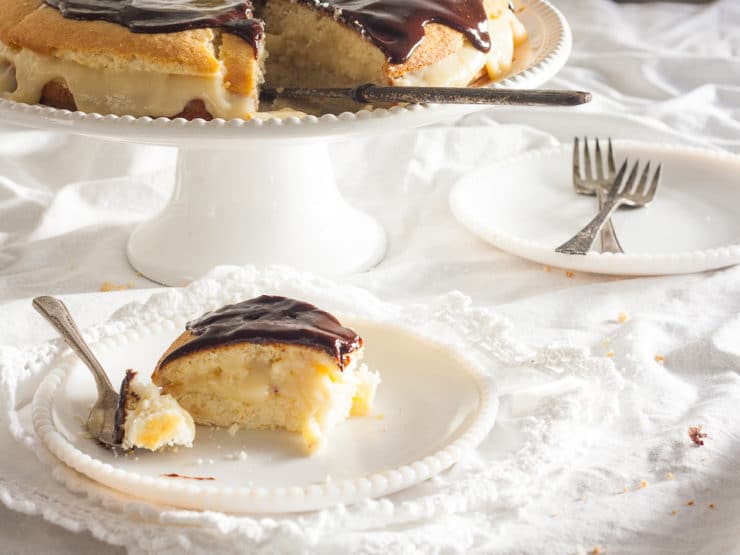
The widespread 19th century usage of the term Boston cream cakes (for cream puffs) and possibly also Boston cake/Boston favorite cake (for yellow butter cake, as in Eliza Leslie’s The Lady’s Receipt-Book, Philadelphia, 1847) probably led to the addition of that municipality to the increasingly popular new “cream pie.” The April 1916 edition of American Cookery (formerly The Boston Cooking-School Magazine) explained: “Boston Pies. As we understand the matter, these ‘pies’ are a plain, cheap cake-mixture baked in round, layer-cake pans; the filling for Washington Pie being jam or jelly, for Cream Pie a mixture known as ‘English Cream,’ while the filling for a Chocolate Washington Pie is an English Cream in which chocolate is melted.”
The earliest recipe using the name “Boston Cream Pie” and indeed the first actual record of the term I could find was in The Methodist Almanac 1872 edited by W. H. De Puy (New York, page 57): “Boston Cream Pie. Cream part: One pint of new milk, two eggs, three table-spoonfuls of sifted flour, five table-spoonfuls of sugar. Put two thirds of the milk on to boil, and stir the sugar and flour in what is left. When the rest boils put in the whole and stir until it cooks thoroughly. When cool flavor with vanilla or lemon. Crust part: Three eggs, beaten separately, one cup of granulated sugar, one and a half cups of sifted flour, one tea-spoonful of baking powder. Divide in half; put in two pie tins, and bake in a quick oven to a straw color. When taken out split in halves, and spread the cream between.” The cake batter is nearly identical to that of the “Custard Cake” in The Cultivator & Country Gentleman of 1866, while The Methodist Almanac substituted flour for cornstarch and offers a choice of vanilla or lemon flavoring in the pastry cream. At that point, “cream pies” were still without a topping – chocolate or otherwise.
In the April 1916 edition of American Cookery, the magazine’s recipe for “Washington Pie, Custard Filling, or Boston Cream Pie” ended: “… sift confectioner’s sugar over the top.” The 1934 edition of The Boston Cooking-School Cook Book by Fannie Farmer (Boston) included a “Cream Pie (Boston Cream Pie)” – for the first time adding Boston (previously only citing “Cream Pie”), but one without a topping. As late as Meta Given’s Modern Encyclopedia of Cooking (Chicago, 1951), the recipe is listed as “Washington Pie (Boston Cream Pie)” and was made from sponge cake filled with “cream or Lemon Pie Filling” and “sprinkle powdered sugar over the top.”
A rare early record of a chocolate-topped version was “Chocolate Pie” appearing in Melrose Household Treasure by a Committee of the Congregational Society (Melrose, MA, 1877), a yellow butter cake filled with chocolate pudding and covered with a rigid chocolate icing, the latter directing: “Two tablespoons of chocolate, one-half cup of sugar, white of one egg; beat the egg to a froth, add sugar and chocolate. Harden in the oven.” A decade later, the “Chocolate Cream Pie” in Miss Parloa’s Kitchen Companion by Maria Parloa (Boston, 1887), longtime food editor of “Good Housekeeping” and one of the first two directors of the influential Boston Cooking School, was closer to the modern concept of a Boston cream pie with a chocolate topping, but not with Boston in its name. Parloa’s treat consisted of three layers of butter cake baked in “deep tin plates” and filled with vanilla custard: “…spread a thin layer of chocolate icing over the cream. Place the other two cakes on top of the first two, and spread the remainder of the icing over them.” For the ensuing half century, the majority of Boston cream pie recipes omitted any reference to a chocolate topping.
The “Washington Cream Pie” in The American Home Diet by E.V. McCollum and Nina Simmonds (Detroit, 1920) consisted of two thin sponge cake layers filled with vanilla custard and topped with white frosting and plain melted chocolate: “And when white frosting has cooled cover top with melted chocolate.” This is quite different from the now standard chocolate glaze. The 1948 edition of Toll House Tried and True Recipes by Ruth Wakefield (New York, 1948) -— a native of East Walpole, Massachusetts and inventor of the chocolate chip cookie -— mentioned, without including an actual recipe for Boston cream pie: “Toll House guests have been brought up on Richmond Chocolate Frosting [a cooked chocolate-pudding like frosting] which we use on Boston Cream Pie.” Wakefield called for a “Hot Milk Cake” (a baking powder sponge cake baked in a 7-inch square pan) as the base of her Boston cream pie. The modern concept of “Boston Cream Pie” using that name and replete with soft chocolate glaze was popularized and made the norm by Betty Crocker’s Picture Cookbook (New York, 1950), based on a one-egg butter cake baked in a nine-inch square pan. Subsequently, chocolate-topped versions made their initial appearance in newer editions of the venerable Fannie Farmer Cookbook and Joy of Cooking in the 1950s. Ganache (French for a “horse’s lower jaw,” but also slang for “idiot”), a simple, but intensely rich and flavorful chocolate and cream mixture, began appearing in American baking in the 1950s and grew increasingly popular over the years as a Boston cream pie topping.
Boston cream pie emerged as an American icon. In 1958, Boston cream pie was the dessert served at the U.S. Exhibit at the Moscow Exhibition, made famous by the Khrushchev and Nixon debate on “freedom” in the kitchen on July 24. Also in that year, Betty Crocker released a Boston cream pie mix. Menus from the Kennedy White House commonly featured Rose Kennedy’s recipe for Boston cream pie (butter cake with pastry cream and chocolate glaze), a favorite of the Kennedy clan. On December 12, 1996, the Commonwealth of Massachusetts adopted Boston cream pie as the state’s official dessert. This triumph, over such formidable competition as the toll house cookie, Fig Newton, and Indian pudding, bespeaks the enduring popularity of Boston cream pie in particular and cakes in general. Frank Sinatra marked the occasion of his 82nd birthday on December 12, 1997 with his three favorite cakes -— banana, coconut, and Boston cream pie. And Old Blue Eyes was far from alone on opting for Boston cream pie for a birthday cake. Unlike many other earlier layer cakes that have disappeared, Boston cream pie can still be found at bakeries, restaurants, supermarkets, and school cafeterias throughout the country. October 23 is National Boston Cream Pie Day.
Recommended Products:
We are a participant in the Amazon Services LLC Associates Program, an affiliate advertising program designed to provide a means for us to earn fees by linking to Amazon.com and affiliated sites. As an Amazon Associate I earn from qualifying purchases.
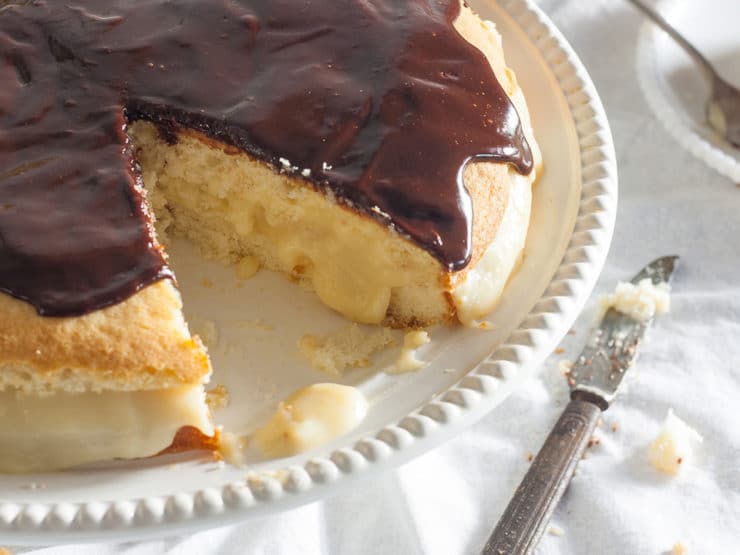
Food Photography and Styling by Louise Mellor
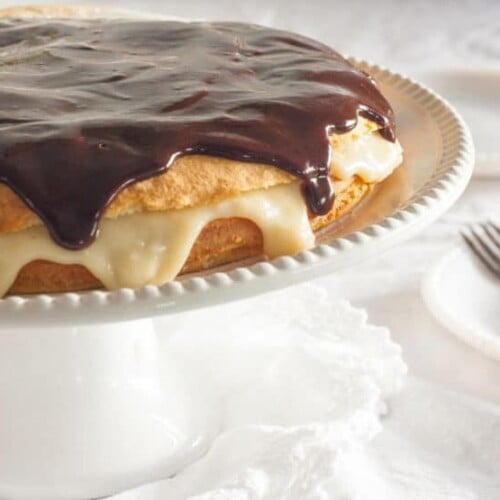
Boston Cream Pie
Ingredients
Custard Filling Ingredients
- 2 cups milk (17 ounces/485 grams)
- 1/2 vanilla bean, split lengthwise (or 1½ teaspoons vanilla extract)
- 2/3 cup granulated sugar (5 ounces/140 grams)
- 1/3 cup all-purpose flour, or 3 tablespoons flour and 2 tablespoons cornstarch (1.4 ounces/40 grams)
- 1/8 teaspoon salt
- 2 large eggs, lightly beaten (3.5 ounces/100 grams)
- 2 tablespoons unsalted butter (optional) (¼ stick/1 ounce/30 grams)
- 1 tablespoon rum (optional)
Cake Batter Ingredients
- 2 cups sifted cake flour or 1 2/3 cups all-purpose flour, sifted (7 ounces/200 grams)
- 1 cup granulated sugar (7 ounces/200 grams)
- 2 teaspoons double-acting baking powder
- 1/2 teaspoon salt
- 1/3 cup unsalted butter or vegetable shortening, softened (65 to 67°F) (2.5 ounces/75 grams)
- 3/4 cup milk (6.375 ounces/180 grams)
- 1 1/2 teaspoons vanilla extract, or 1 teaspoon vanilla and 1 teaspoon almond extract
- 1 large egg (1.75 ounces/50 grams)
Glaze Ingredients
- 3 ounces semisweet or bittersweet chocolate, chopped (85 grams)
- 2 tablespoons granulated sugar (1 ounce/25 grams)
- 2 tablespoons water
- 3 tablespoons unsalted butter, softened (65 to 67°F) (1.5 ounces/45 grams)
- 1/2 teaspoon vanilla extract
NOTES
Instructions
To Make Filling
- In a 2-quart heavy bottomed saucepan, heat the milk, vanilla bean, and 2 tablespoons sugar over medium heat, stirring occasionally, until small bubbles appear around the edges. (The sugar helps to prevent the milk from scorching.) Remove from the heat, cover, and let steep until the vanilla infuses the milk, about 10 minutes. Remove the vanilla bean and return to a simmer. Meanwhile, in a medium bowl combine the remaining sugar, flour, and salt. Gradually stir in the warm milk.

- Return to the saucepan and cook, stirring constantly, over medium heat until the mixture bubbles, then boil for an additional 2 minutes. Remove the saucepan from the heat and gradually beat half of the milk mixture into the eggs. Scrape the egg mixture back into the saucepan, stirring constantly. Cook over medium heat, whisking constantly until the mixture thickens or reaches 160°F, about 2 minutes.Remove from the heat and, if using, add the butter.

- Continue to whisk for about 20 seconds, then pour into a bowl. If using vanilla extract and/or rum, add it now. Press a piece of plastic wrap against the surface and let stand at room temperature until cool, about 1 hour. The custard can be stored in the refrigerator for up to 3 days. Do not beat the cooled custard or it will break down.Position a rack in the center of the oven. Preheat the oven to 350°F (325°F for a convection oven). Grease two 9-inch round baking pans or one 9-inch springform pan, line the bottom with parchment paper or wax paper, grease again, and dust with flour.

To Make Cake Batter
- In a large bowl, combine the flour, sugar, baking powder, and salt. Add the butter, 1/4 cup milk, and vanilla.

- On low speed, blend together, about 30 seconds. Increase the speed to medium-high and continue beating for 2 minutes. Beat the egg with the remaining ½ cup milk. In 3 parts, beat the egg mixture into the flour mixture, about 20 seconds after each addition, until smooth.

- Divide the batter equally between the prepared pans. Bake until a tester inserted in the center comes out clean and the cake springs back when lightly touched, about 25 minutes for 2 pans or 30 to 40 minutes for a springform pan.

- Let cool in the pans for 10 minutes, then remove the cake to a wire rack and let cool completely, at least 1½ hours. The cake can be wrapped and stored at room temperature for up to 3 days or in the freezer for up to 3 months.

To Assemble
- If using a springform pan, cut the cake horizontally in half. Place a cake layer on a serving plate, spread with the filling, and top with the second cake layer. Refrigerate while preparing the glaze.

- To make the glaze: In the top of a double boiler, combine the chocolate, sugar, and water and place over barely simmering water until melted. Remove from the heat and stir in the butter and vanilla. Let stand, stirring occasionally, until slightly thickened, 15 to 30 minutes. Pour the glaze over the cake, allowing a little to drip over the sides. Refrigerate until chilled. Boston cream pie is best the day it is made, but can be covered and stored in the refrigerator for up to 2 days. Remove the cake from the refrigerator about 20 minutes before serving.

Nutrition

tried this recipe?
Let us know in the comments!
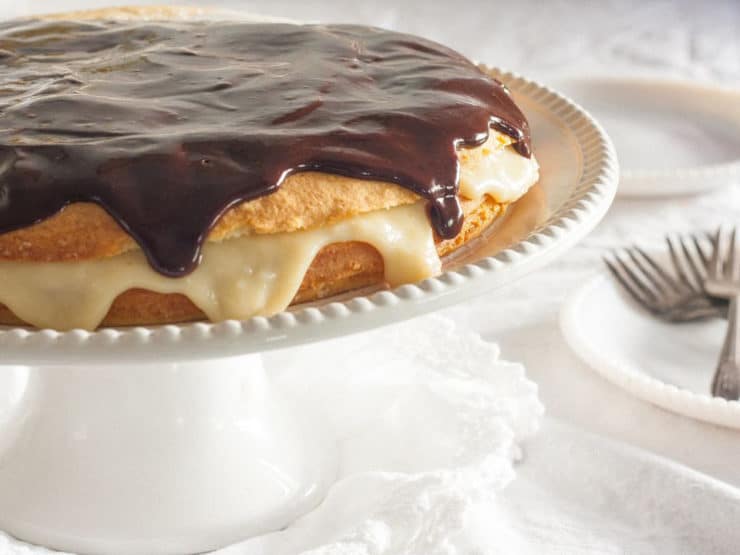
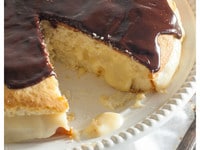
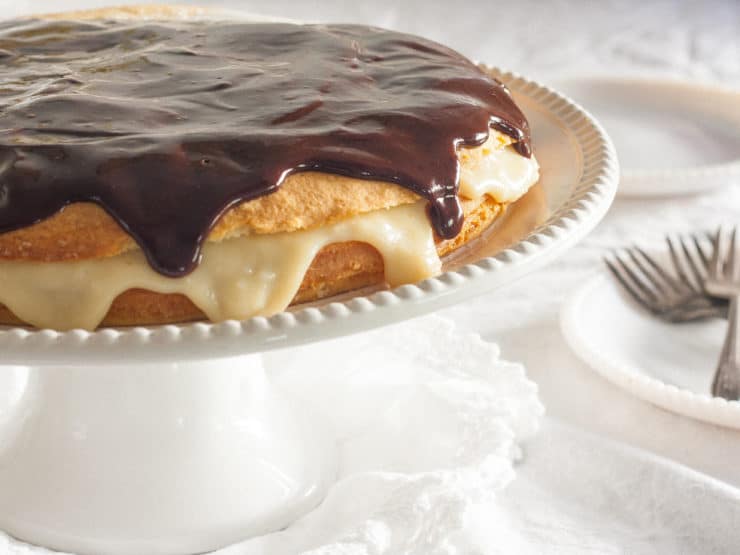
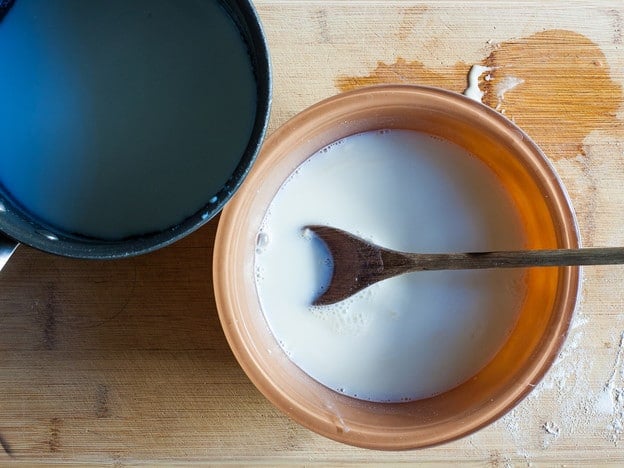
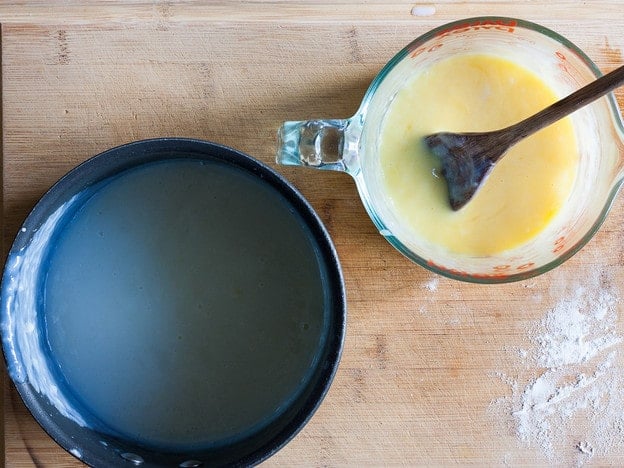
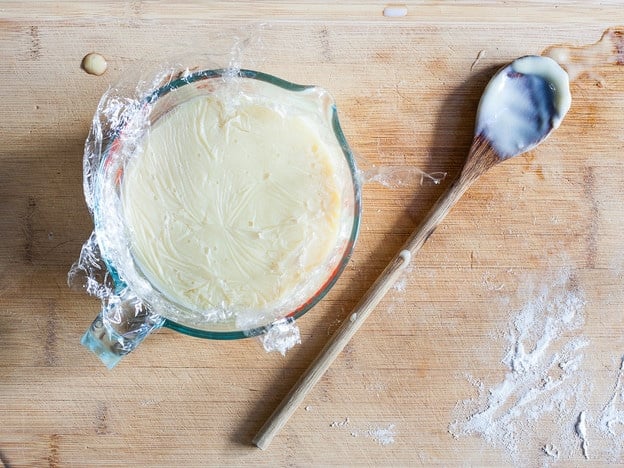
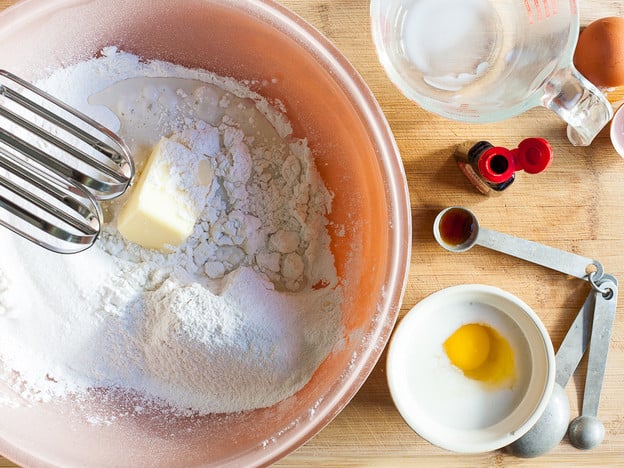
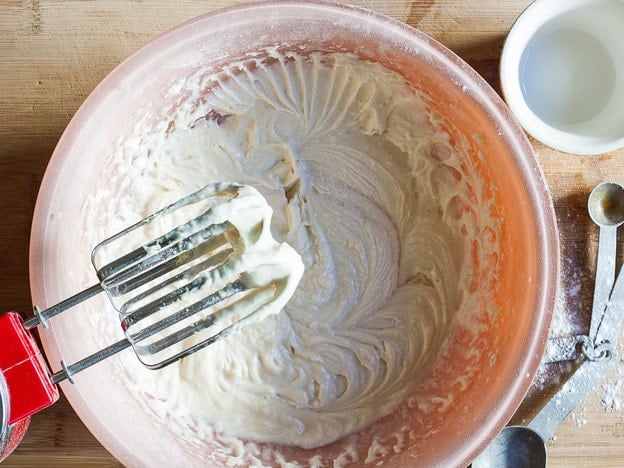
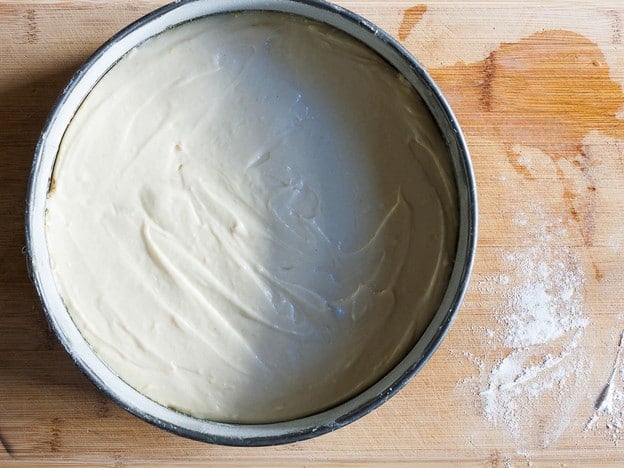
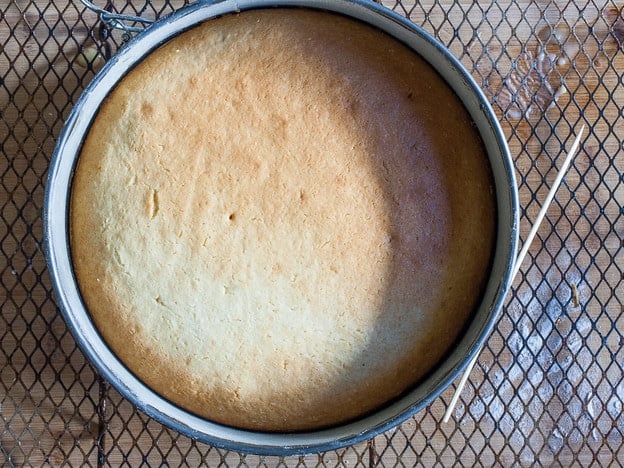
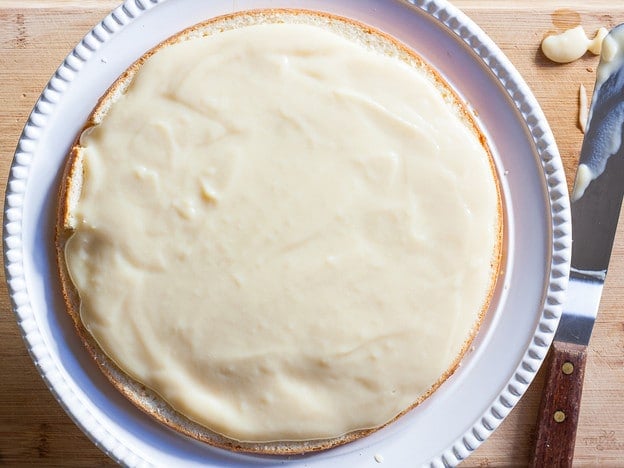
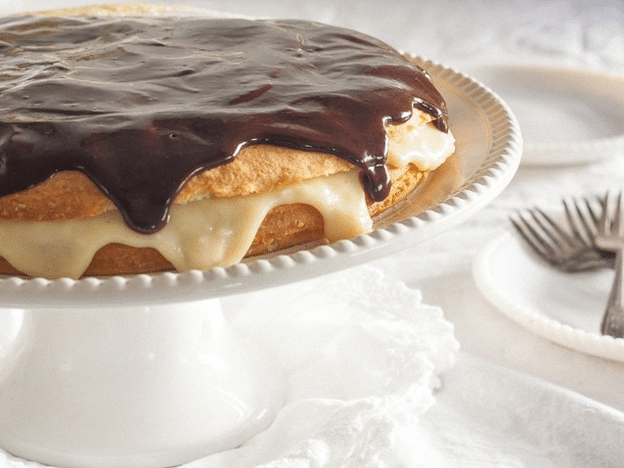


Boston cream pie is an iconic dessert originating at the Parker House ( parker house roll fame ) in Boston Massachusetts.
Wonderful recipe. Yum
Thank you for this lovely recipe and the history lesson.I have never made a Boston Cream Cake before but am sorely tempted now.Thay have always been a favorite here but maybe now we can have a homemade one.Thank you so much!!!!!!!
Amazing! My daughter’s moving to Boston so this seemed like the perfect dessert for her going away celebration. Our friends practically licked the plate after the last slice was served. Increased the cake recipe by 1/2 to give the pie a little more height. Highly recommend.
Made this for Father’s Day. It looked great but the cake was too heavy and the glaze too sweet. Will look for a recipe that has a sponge type cake. The filling was good. Thanks for the history…very interesting.
Absolutely fabulous cake! I did use the variations for a richer cake and was satisfied, and so were my guests. I will definitely make this again sometime!
Boston Cream Pie is my dad’s favorite (and mine), so I tried this recipe as a surprise for his birthday. I’ve never made custard or a homemade cake before, but everything came out amazingly well. The only issue I encountered living at a higher altitude (Denver) was that the cake came out a bit dry, even after only baking for about 18 minutes, so next time I will take it out even earlier. Unlike some of the other reviewers, I think the amount of custard was perfect for this cake and the consistency was just fine. The flavors were all great and I will definitely be making this one again! Thanks for the recipe!
I made the cake, filling, and glaze, exactly as written in the recipe (I used cake flour. I used vanilla extract. I had no rum but it is optional). I changed one thing during assembly by cutting each cake layer in half, making a four layer cake. There was just enough filling to give each layer a nice coating. The chocolate glaze turned out great. I love this version of BCP. Thanks for posting it.
Too much custard for the size of cake, so I used some on top also. Then drizzled chocolate over top also. I was disappointed in appearance even though it had a very good flavor.
Too much filling for just between the two layers. Was also too thin & ran out the sides even though i cooked to thick consistency. Very good flavor. Could have made 1/2 the amount.
Tori, I thought you might like to know that over on Ravelry in the Cooking from Scratch group, we are making your Boston Cream Pie recipe during the month of March. We started a Cook-a-long for our group inspired by the King Arthur Flour Cook-a-long. I chose the month of March and your recipe for Boston Cream Pie or BCP as we are calling it. My mom cooked a lot from scratch all her life for all of her family. She died in November of 2016 and I wanted to make BCP in her memory, so I chose your recipe. This cake/pie was something she made often for her husband and three little girls. Mom lived to age 91, so we have lots of good memories of the meals she made for us.
Thanks for the wonderful recipe, the story behind this dessert and helping to keep our memories alive. I have given you credit for the recipe on Ravelry.
Best regards,
Teresa Rouzer
Burlington, North Carolina
I found the pastry cream much too thin/runny – it did not support the top layer, and only a very small quantity stayed in the cake, most ran out the sides. The resulting cake tasted okay, but not good enough to make up for its poor appearance! Next time I will just make a trusty ol’ vanilla pudding for the filling.
My first try turned out fairly decent, and I used 18% cream for the filling instead of milk. Will be doing another with a few mods this week. Thanks for posting.